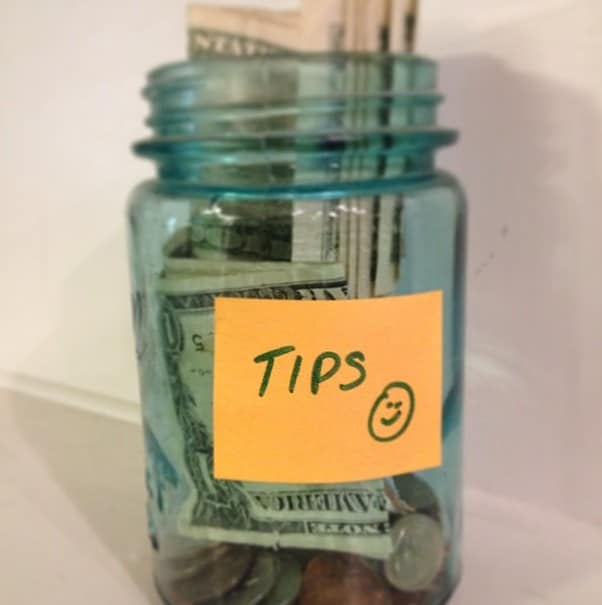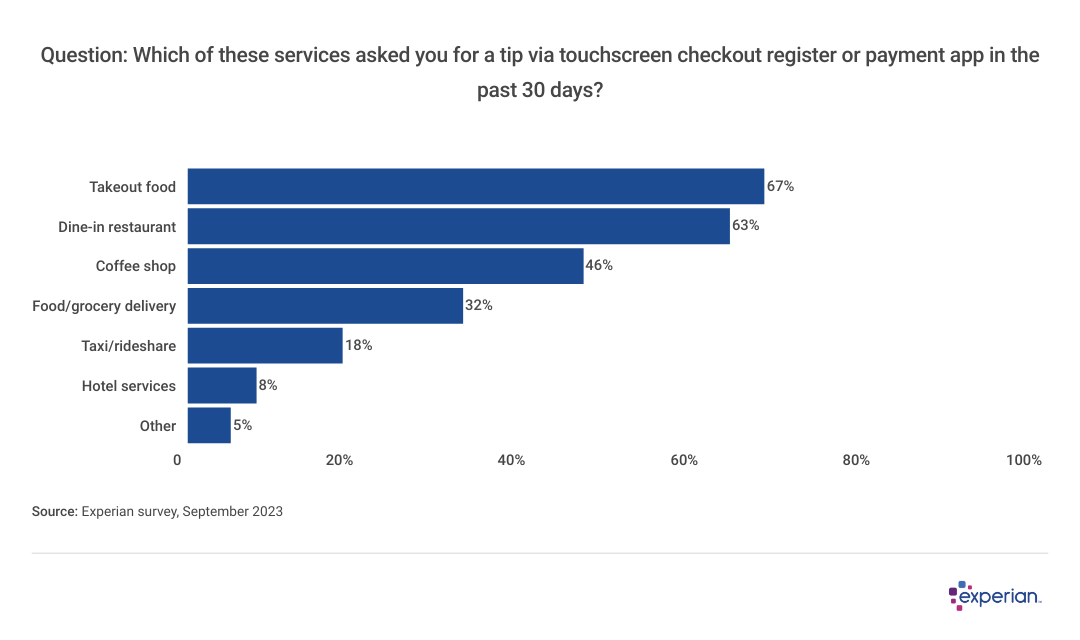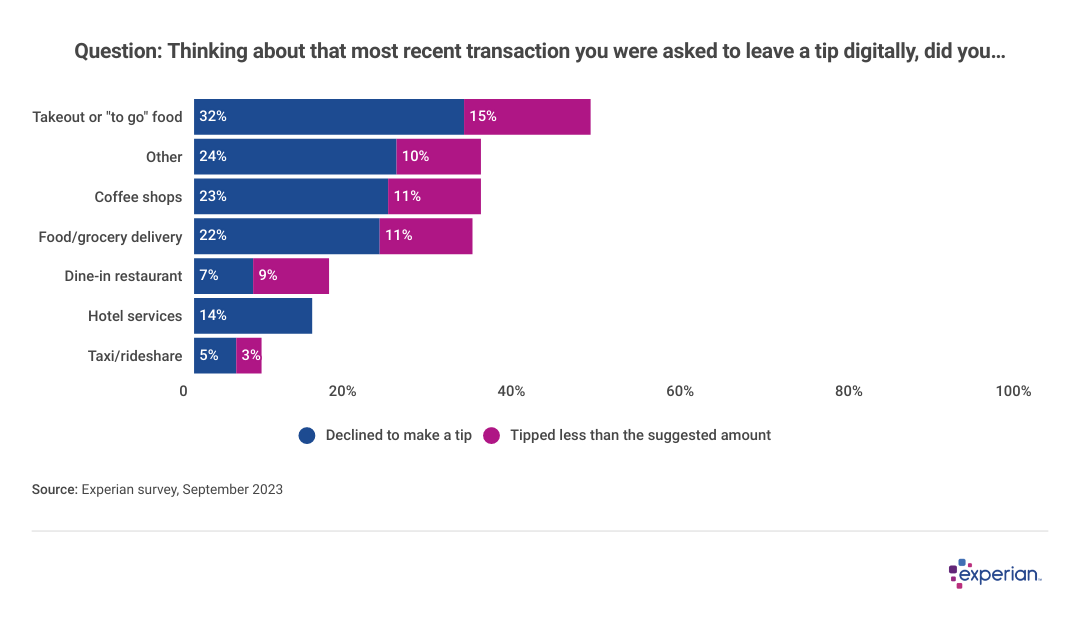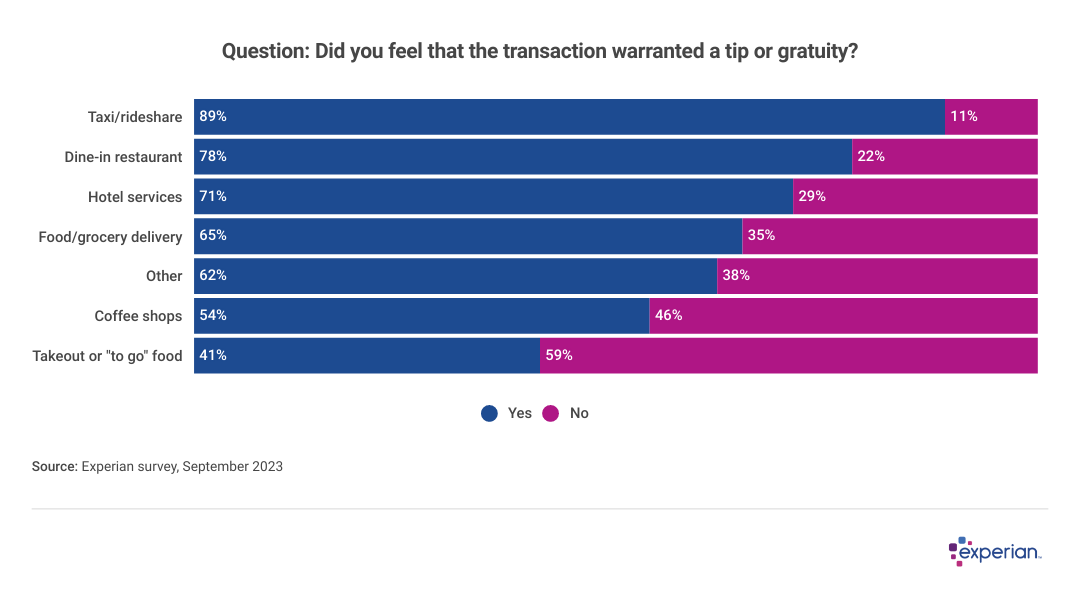Tipping Fatigue Explained
Are you exhausted about tipping everyone and their brother when you make a purchase? If so, you’re not alone and you’re suffering from tipping fatigue.
Keep in mind, this isn’t about being tired of having to tip in general. It’s feeling fatigued when buying something in person, on a screen with something like Stripe. Then, the checkout person spins the screen around to show a tip prompt. Even if all the person is doing is handing you a bag across the counter.

Touchscreens causing tipping fatigue—and frustration
Experian found that consumers, by and large, continue to tip when they receive an electronic prompt. This would be through an app or touchscreen register. However, there are circumstances where they won’t tip at all. In addition, some consumers say financial constraints are preventing them from tipping more than they would like, compared with the same time last year.
As we rely less on cash, tip asks become more impersonal
Tipping is part of U.S. culture, with its history in everyday transactions going back to at least the 19th century. It’s also much more widespread than in other nations, to the consternation of many foreign tourists visiting the States.
For example, when traveling overseas, you’ll discover that Europeans, for example, don’t expect tips the way American service providers do.
Experian’s survey didn’t look at “traditional” tipping behavior involving cash transactions, usually reserved for sit-down restaurants, hotel staff and holiday tipping. Instead, it took a close look at the rise of digital tipping — a relatively recent trend in which a customer is prompted during a transaction with a screen or digital pad at the point of sale.
Tipping is seemingly everywhere your card is accepted
Point-of-sale tipping began about 10 years ago. That’s when mobile payment tech companies began to harness the power of both mobile payments and provide credit card processing technology to small- and mid-sized businesses. This included coffee shops, food trucks and street vendors. As the technology spread, so did the number of industries using it — including its tipping function.
Two-thirds of those surveyed said a touchscreen asked for a tip when they paid for their takeout or to-go order — more than any other electronic transaction. That could be a function of food orders being more commonplace than other transactions. However, tipping used to be nonexistent on many transactions. This was outside of a tip jar at the checkout counter.

It was more than 10 years ago that I wrote The Everything Etiquette Book. It included a lot of advice about to tip or not to tip. If I were writing that book today, my advice would be very different, given these technological advances.
I wrote this book about modern-day manners and etiquette. Then I got trained as a certified etiquette and protocol officer. You can trust that I provide good advice, including about tipping.
Tipping fatigue from everyday businesses
Save this article and we’ll send it to your inbox. Plus, we’ll send you more great links each week.
In Experian’s survey, researchers did not expect that traditional places where consumers encountered tip prompts — such as coffee shops, rideshares and pizza parlors — would cover all tip prompts. For that reason, survey takers had the option to add their own observations.
Here are some of the more surprising transactions where consumers surveyed said they received a digital tip prompt:
- Piercing/tattoo shop
- Political donation
- Convenience store
- Massage therapist
- Ice cream shop
- Baseball game
- Liquor store
- Beauty salon/barber shop/hair stylist
- Gas station
- Dog groomer
- Smoke shop
- Car wash
Tipping pushback most evident at the checkout register
Has there been a reaction to the seeming ubiquity of tipping? Judging by some recent headlines, the backlash appears to be on.
An opinion column published by The Guardian in August, for example, put it bluntly: “There is now almost no payment transaction in the U.S. that doesn’t involve a prompt for a tip.”
However annoyed consumers may be, they don’t take it out on workers. For example, those who traditionally receive tips, such as hotel workers and waitstaff, are not on the receiving end of most consumers’ wrath.
Similarly, most consumers will consider tipping, provided that it’s for a service where tipping had existed long before apps and customer-facing registers became the norm.
The service industry, guilt and inflation complicate tipping
Tips are an essential part of an overall wage for many service workers. This is particularly true for those workers where service minimum wages are below that of a state-mandated minimum wage in many states. Many respondents said they are aware that tipping is important for workers who rely on tips to make a living.
Nonetheless, there’s some polarization among the overall population about tipping. Interestingly, this isn’t along the lines of age, household income or gender. Some tip generously. Others indicate that they shouldn’t be subsidizing an owner’s payroll with a tip, particularly for point-of-service transactions.
Many consumers in the survey acknowledged feeling the pinch. This was because of inflation or unemployment. At the same time, they feel increasingly conflicted about their own personal finances and those of the workers when it comes to tipping. And still other respondents feel pressure to tip. This is because it is expected or because of impersonal prompts from digital systems.
Where I do not feel tipping fatigue
It’s clear that tipping prompts are exhausting. However, there are times when it can be helpful. For example, whenever I get a massage or a haircut, I tip. Usually, I’ll need to get out my cell phone to use the tip calculator.
However, my hair salon has one of those tipping screens that we’ve been talking about. So, when the cashier spins it around and it prompts me for the tip — and then tells me different percentages — that is truly helpful. That’s because this is a scenario where I’d planned to tip anyway.
On the other hand, I don’t like it when I get to Panera Bread and the person who takes my order prompts for a tip. Or the person who hands me my pizza at the local takeout place. Or the cashier at Starbucks.
These are not places where people are waiting on tables. Having been a waitress in college, where I earned well below minimum wage, I understand how important tips are to supplement income. However, if you’re being paid a wage well above what waitstaff gets, I don’t think that we consumers should have to tip.
We can tip if we want to. But it’s exhausting to be prompted each and every time I check out. No wonder we all have tipping fatigue
Methodology
Experian surveyed 1,146 adults with a debit card about their views on tipping. Survey conducted September 17-18, 2023. The sample was collected using a third-party company and was not from Experian’s consumer credit database.
This story was produced by Experian and reviewed and distributed by Stacker Media.




